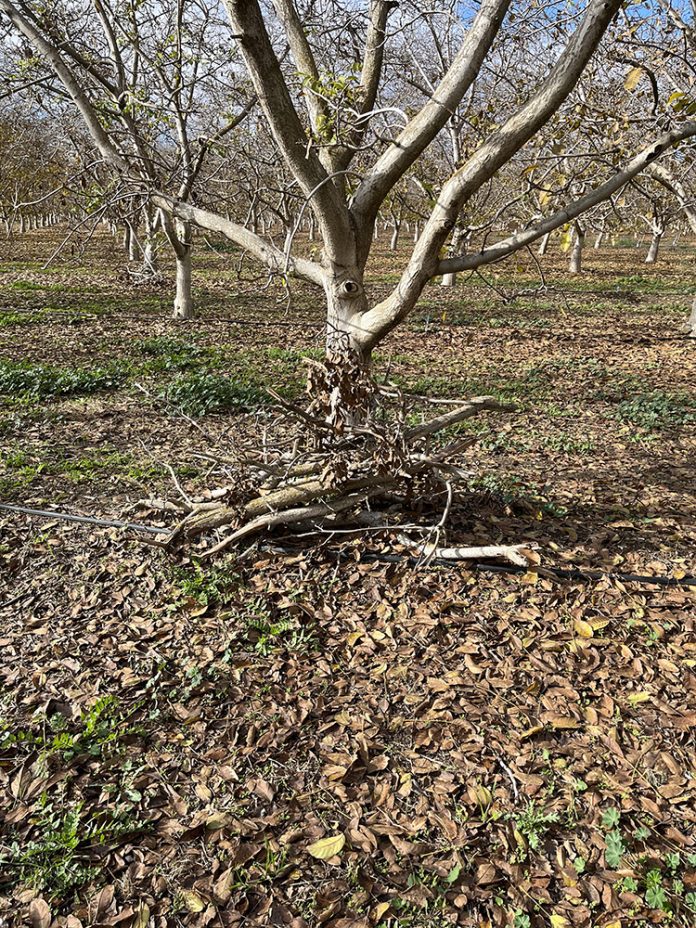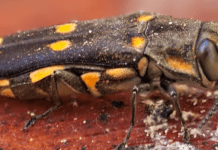
There are several good reasons to consider implementing a preemergent herbicide program in your orchard: residual activity, resistance management and it takes place during a slower time of the year.
UCCE Weed Specialist Brad Hanson said for getting a jump on weeds, the longer duration of effectiveness and performance of preemergent herbicides should make them the foundation of a weed control program in orchards.
“Get preemergents in the soil before the major weed flush in late fall and early winter,” Hanson advises. “You can control 80% of the weeds and will have fewer weeds later in the season.”
It is the timing of preemergent applications that is critical. Hanson said there are two schools of thought about when to apply preemergent herbicides: Wait until January and risk missing in the early germination of weeds or early application in early December to catch the first flushes. He advises the second approach as there is less risk of orchard inaccessibility due to rain. The early weed flushes targeted include winter annual grasses which emerge as soils cool in the Sacramento Valley as well as fleabane, malva and fillaree farther south.
The UC IPM weed management guidelines note that although preemergent herbicides have a greater initial cost than most contact herbicides, the residual weed control may provide sufficient control that a postemergent application could be eliminated.
Hanson said sequential treatments of preemergent herbicides involves an initial herbicide application in the November to January time frame depending on location and a second application in March to target summer annual grasses.
“You have to look at this as using the right tool at the right time,” Hanson said. “Half the rate at the right time is better than twice the rate at the wrong time.”
Sequential Applications
Reliance on the residual effect of preemergent herbicides may lead growers or crop advisors to use high rates of the product or delay applications. UCCE Orchard Systems Advisor Phoebe Gordon said. Sequential applications use the same amount of herbicide only in two doses to better target problematic weeds.
Bayer Crop Science Customer Business Advisor Manuel Jimenez agreed, noting growers using dual applications timed in November to March implement this preemergent herbicide strategy in orchards.
“Materials are pricey, but a good investment,” Jimenez noted. This year’s higher weed pressure is adding to the seed bank in the soil and may mean an even weedier 2024.
He said the dual approach can be effective particularly if a broad-spectrum product is mixed with an herbicide that targets resistant weed species.
Applying preemergent herbicides includes paying attention to orchard floor conditions in addition to timing. The application will be more effective if the orchard floor is smooth with no ruts to channel away herbicide or leaf trash to prevent it from hitting the soil.
Cameron Zuber, UCCE orchard crops advisor in Merced County, said with preemergent herbicides, the aim is to inhibit the growth of seedling roots, shoots or both. The herbicides need to be in the top layer of the soil, not on top of the soil, to be effective. He said preemergents tend to bind to organic matter in the soil or the soil itself which helps limit leaching, but it doesn’t stop it from happening. Clearing orchard berms of leaf cover or debris allows the herbicide to hit the surface of the soil.
Zuber said most preemergents need between 0.25 to 0.75 inches of rain or irrigation within a few weeks of the application for best results. The UC publication Sac Valley Orchard Source noted that even in 2013-14 drought conditions, many of the preemergent herbicides worked surprisingly well despite several weeks on the soil surface with minimal incorporation. To maximize the impact of preemergence herbicides in a weed management program, a short irrigation set is advised if rain is not forecast.
Tank mixes or sequential herbicide applications broaden the spectrum of weeds controlled and reduce selection for resistant populations. Tank mixes can take several forms: preemergent and postemergent herbicides to control emerged weeds and provide residual control; combining herbicides with activity on grasses with other materials with broadleaf activity; or combining material with different modes of action but overlapping activity on weed species.
Weed Survey
The UC Integrated Weed Management website advises growers or crop consultants to conduct a late fall weed survey in their orchards after the first rains of the fall when winter annuals have germinated and started to emerge. This helps by identifying remaining summer species and perennial weeds that escaped last year’s weed control program. Fall monitoring will also identify winter species.
Zuber said it really helps to understand what was missed from that year and have a sense of what could be problems going into the next year. By “miss” he means not identifying the weed in the first place to be targeted. Also, the weed may have been identified and targeted, but the product used and its effectiveness or lack of was not recorded. The UC Davis Weed Research Center website has weed ID tools.
Berm or Middles?
Many growers tend to focus on their berms/tree rows versus the middles/alleyways with any herbicide management, but especially with preemergents, Zuber said. While the needs for preemergent in the middles can be debated due to costs, it is still a part of the managements as nothing lives in a bubble and seeds tend to move. The middle can be the source of those seeds you are trying to inhibit, so incorporating middles (either through identification or other means) is important.
Hanson said while most preemergent use is in the tree row, he is seeing more ‘trunk to trunk’ weed control in orchards. This approach can cut down on mowing and spraying in the middles and the resulting soil compaction.
Newly Planted Orchards
Weed control is especially important during the first few years of orchard establishment. Competition from weeds during this period can result in reduced tree vigor and productivity. Weedy orchards may require several more years to become economically productive than orchards with effective weed management. Regardless of the method to control weeds, care must be taken not to injure the young trees with herbicides or to mechanically damage the trunk or roots. As the orchard becomes established, competition from weeds is lessened as shade from the tree canopy, especially in densely planted orchards or in orchards with large-stature trees, reduces weed growth.
Preemergent herbicides should only be applied in newly planted orchards after the soil has completely settled around the tree to reduce the chance of tree damage. The risk of damage is greater if the trees settle after treatment because the herbicide has a greater chance of coming into direct contact with tree roots.
Regardless of the postemergence herbicide used, protect the foliage and bark of young trees from direct spray or spray drift to avoid tree injury. Young trees are very susceptible to damage from herbicides. Placing plastic or cardboard wraps, cartons, or sleeves around the tree trunks is helpful in preventing herbicide contact with young trees.










